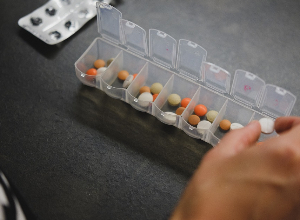What is biotherapy? A focused look at inflammatory diseases
Published Oct 24, 2019 • By Camille Dauvergne
What is biologic therapy? How can it be used to treat inflammatory diseases? At what point and under what conditions can a patient have access to biologic therapy? We explain it all!

Biotherapy (also known as biologic therapy or biological therapy) is built upon medications and therapeutic strategies obtained from living organisms and biological processes. At the most basic level they consist of molecules collected from living things such as yeasts, microbes, genes, cells, tissue, etc. or from substances harvested from organisms such as hormones, antibodies or interleukins.
Different kinds of biotherapies
The term “biotherapy” covers several different types of therapy.
- Cellular therapy: Stem cell or differentiated cell transplants
- Tissue therapy: Tissue transplants
- Gene therapy: Gene transplants and other procedures performed on a genetic level
- Biomedicine: Medications that imitate molecules found naturally in the human body and are synthesized by living organisms (growth factors, interleukins, recombinant proteins)
Biotherapy and inflammatory diseases
Inflammatory diseases appear in various forms; they can occur in the joints (rheumatoid arthritis, psoriatic arthritis, ankylosing spondylitis), in the skin (psoriasis) or even in the digestive system (Crohn’s disease, ulcerative colitis).
How does it work?
All of these illnesses result from immune system dysfunction that may manifest as fever, liver disorders, cardiovascular complications, joint damage or intestinal perforations. At the root of these dysfunctions, we find cytokines (an immunity substance that regulates cell multiplication) and T and B lymphocytes (responsible for immunity).
The biotherapies used to treat these illnesses focus on pro-inflammatory cytokines and/or T and B lymphocytes. Their end-goal is to keep these faulty substances from provoking inflammations by blocking inflammation mechanisms.
When can a patient start on biotherapy?
Starting a biologic therapy shouldn’t be taken lightly. The best time depends on the disease, its progression and the patient’s physical state. It’s an important decision that should be thought over carefully and supervised by a physician. Biotherapy prescriptions are limited due to high costs and risks of infection.
Inflammatory joint diseases
Biotherapy is rarely prescribed just after diagnosis. In the case of rheumatoid arthritis, patients are generally given anti-inflammatory medications: analgesics followed by methotrexate, an antimetabolite, before starting on biologic therapy.
Inflammatory skin diseases
In the case of psoriasis, the choice of biologic therapy depends on the severity of the case and its impact on the patient's quality of life. Generally, a patient is put on a topical treatment (cream, mousse, gel) and if that doesn’t work, immunosuppressant drugs. A biologic therapy is only prescribed as a last resort and generally consists of anti-TNF agents, administered in drip form or subcutaneously (TNF is a protein that sets off the inflammatory process). A patient may also be injected with an interleukin (pro-inflammatory proteins) inhibitor.
>> Ask your questions about biotherapy for psoriasis on the forum
Biotherapy is sometimes prescribed as a second-line treatment (i.e. in case of failure of the first-line treatment) for certain specific forms of psoriasis such as psoriatic arthritis.
Inflammatory digestive diseases
Biotherapy treatment aims to limit surgical operations and the use of corticosteroids. Sometimes an anti-TNF agent may be prescribed at the beginning of treatment for patients suffering from Crohn’s disease or ulcerative colitis.
How effective is biotherapy?
The efficacy of biologic therapies has been demonstrated in numerous conditions, and notably in inflammatory diseases. It usually takes about 12 weeks before their efficacy can be judged, but in some cases, patients report an improvement in symptoms in only 15 days. Still, biologic therapies should only be taken under medical supervision: the physician may prescribe additional tests to verify treatment effectiveness and the patient’s response.
What are the main side effects?
Biologic therapies may provoke side effects which usually cease as soon as the treatment is stopped. Side effects may be reduced or even avoided by paying special attention to hygiene measures, getting recommended vaccinations, etc.
Immediate risks
When taking biotherapy, a patient may experience a violent allergic reaction, called anaphylaxis. Other reactions may also appear during injection as the patient’s body may develop antibodies against the molecule. As is the case with any injection, soreness may develop at the injection site.
Infection risks
Biotherapy slows down the immune system and may therefore cause immunodepression, meaning the body is no longer able to protect itself from bacterial and viral infections. The patient may contract sometimes severe opportunistic infections. You should contact your physician immediately if you experience any infection symptoms.
A history of resistant infections, being over the age of 65, the presence of other chronic conditions or respiratory disease, and taking corticosteroids are all risk factors that increase the chances of infection.
What other difficulties might a patient run into?
Some biologic therapies need to be injected at home, which means the patient must learn to self-inject.
Warning: This article is a general overview and is not meant to be used as medical advice. Each patient is different and may encounter complications or variables in treatment not mentioned in the above text. Talk to your physician before starting any treatment.
Was this article helpful to you? Have you tried biotherapy for your condition?
Share your thoughts and questions with the community in the comments below!
Take care!
This article was written by Louise-B with the assistance of Camille Dauvergne, a 4th-year Pharmacy student.

 Facebook
Facebook Twitter
Twitter


